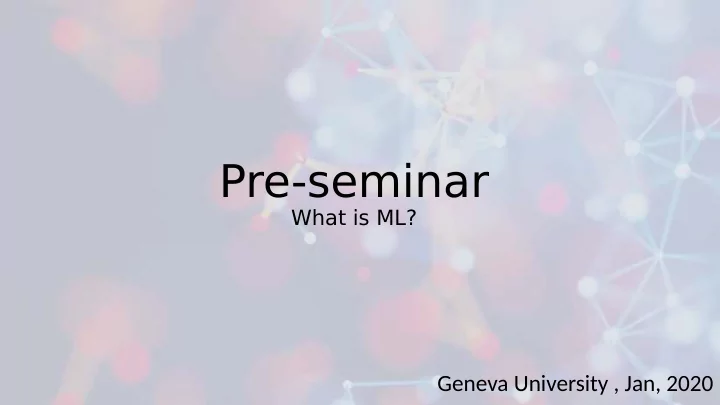

Pre-seminar What is ML? Geneva University , Jan, 2020
● What is Machine learning? ● What is Dimensionality reduction? ● What is Clustering Analysis? ● What am I doing with ML?
What is Machine learning?
Classification vs. regression
Supervised vs Unsupervised
What is Dimensionality reduction?
What is Clustering Analysis?
What am I doing with ML?
RFI mitigation
Inpaintjng CMB
Inpaintjng CMB
Inpaintjng CMB
Medical physics
Mining cosmic datasets +some cool DS stufg Alireza Vafaei Sadr IPM, Tehran Geneva University , Jan, 2020
Outline Cosmology and BIG data A Quick Review of Applicatjons Anomaly detectjon DRAMA Future directjons
Cosmology/Astrophysics E. Siegel, with images derived from ESA/Planck and the DoE/NASA/ NSF interagency task force on CMB research. From his book, Beyond The Galaxy.
Cosmology and Big data
It is getting hotter! Number of physics submitted manuscripts that include “machine learning” in their abstracts.
A quick review on what people have done
Classifjcatjon htup://cdn.spacetelescope.org/archives/images/screen/heic9902o.jpg
Galaxy zoo challenge htups://www.galaxyzoo.org/
Detectjon
Data cleansing
Simulatjon
htups://towardsdatascience.com/do-gans-really-model-the-true-data-distributjon-or-are-they-just-cleverly-fooling-us-d08df69f25eb
htups://arxiv.org/pdf/1905.08233v1.pdf
Anomaly detectjon The light from quasar pairs reach Earth, although some were absorbed by the gas in the cosmic web, Springel et al. (2005) (cosmic web) / J. Neidel, MPIA
10
Norris, R. P. (2017). Discovering the unexpected in astronomical survey data. Publications of the Astronomical Society of Australia , 34 .
Current projects in SKA (MeerKAT) DS team: Source detection (Mightee, SKAch-I) Anomaly detection WTF, PLAsTiCC RFI simulatjon/mitjgatjon Extended source simulation Observation strategy
A. Vafaei Sadr, B. Bassetu, M. Kunz ISCMI-2019
No Free Lunch Theorems Any two optjmizatjon algorithms are equivalent when their performance is averaged across all possible problems No anomaly detectjon algorithm works for all anomalies No anomaly algorithm is “best” on average. Difgerent algorithms work for difgerent anomalies So lets consider families of anomaly algorithms
Dimensionality Reductjon Anomaly Meta Algorithm htups://github.com/vafaei-ar/drama
Dimensionality reductjon
Clustering
As an example: MNIST
DRAMA (Dimensionality Reductjon Anomaly Meta-Algorithm):
Dimensionality Reduction T echnique • Autoencoder • Variational autoencoder • principal component analysis • independent component analysis • non negative matrix factorization Also newly added: • Convolutjonal (V)AE (1D) • Convolutjonal (V)AE (2D) • Convolutjonal UMAP
Clustering
Clustering
Distance metrics
Comparison with LOF and i-forest: Simulated Real
Benchmark metrics:
AE, VAE, PCA, ICA, NMF, …? L1, L2, L4, Chebyshev, Canbera, …? Semi-supervised or actjve learning DRAMA vs. LOF vs. iforest
Local anomaly in low dimension n f =100
New class anomaly in low dimension n f =100
Local anomaly in high dimension n f =3000
New class anomaly in high dimension n f =3000
Averaged on real data
Widefield ouTlier Finder (WTF) Includes 337 boring objects and 17 interesting AUC: 87 MCC: 26 RWS: 31 interesting boring
Future directjons • 2D convolutjons • PLAsTiCC (Kaggle competjtjons) • Deep learning based clustering • Graphical user interface • Actjve learning mode • Detect and classify • ...
Thanks for your attention. You can fjnd DRAMA here htups://github.com/vafaei-ar/drama
Recommend
More recommend